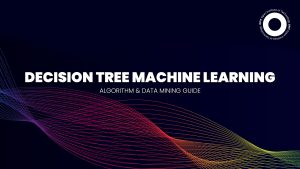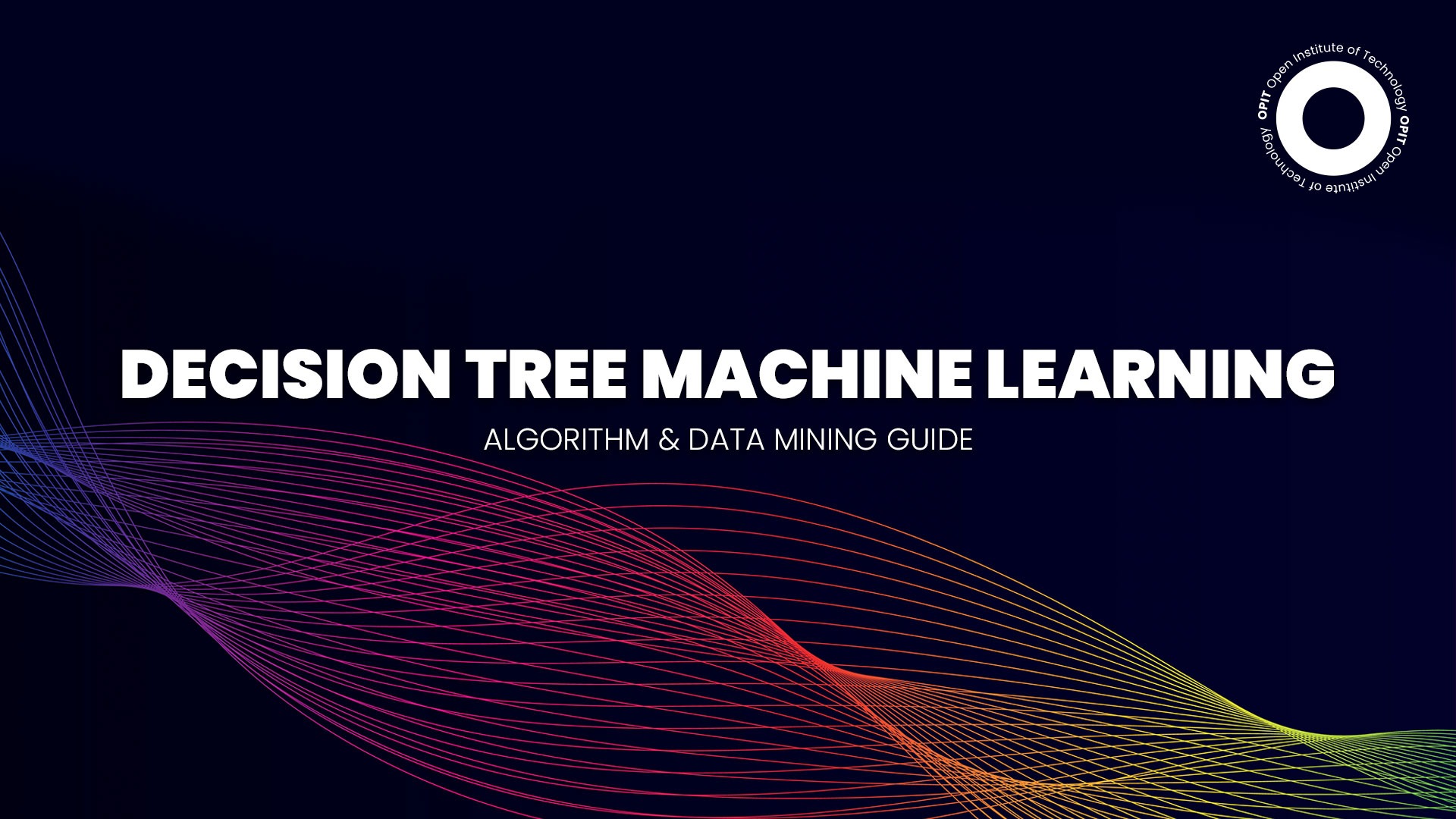

Algorithms are the essence of data mining and machine learning – the two processes 60% of organizations utilize to streamline their operations. Businesses can choose from several algorithms to polish their workflows, but the decision tree algorithm might be the most common.
This algorithm is all about simplicity. It branches out in multiple directions, just like trees, and determines whether something is true or false. In turn, data scientists and machine learning professionals can further dissect the data and help key stakeholders answer various questions.
This only scratches the surface of this algorithm – but it’s time to delve deeper into the concept. Let’s take a closer look at the decision tree machine learning algorithm, its components, types, and applications.
What Is Decision Tree Machine Learning?
The decision tree algorithm in data mining and machine learning may sound relatively simple due to its similarities with standard trees. But like with conventional trees, which consist of leaves, branches, roots, and many other elements, there’s a lot to uncover with this algorithm. We’ll start by defining this concept and listing the main components.
Definition of Decision Tree
If you’re a college student, you learn in two ways – supervised and unsupervised. The same division can be found in algorithms, and the decision tree belongs to the former category. It’s a supervised algorithm you can use to regress or classify data. It relies on training data to predict values or outcomes.
Components of Decision Tree
What’s the first thing you notice when you look at a tree? If you’re like most people, it’s probably the leaves and branches.
The decision tree algorithm has the same elements. Add nodes to the equation, and you have the entire structure of this algorithm right in front of you.
- Nodes – There are several types of nodes in decision trees. The root node is the parent of all nodes, which represents the overriding message. Chance nodes tell you the probability of a certain outcome, whereas decision nodes determine the decisions you should make.
- Branches – Branches connect nodes. Like rivers flowing between two cities, they show your data flow from questions to answers.
- Leaves – Leaves are also known as end nodes. These elements indicate the outcome of your algorithm. No more nodes can spring out of these nodes. They are the cornerstone of effective decision-making.
Types of Decision Trees
When you go to a park, you may notice various tree species: birch, pine, oak, and acacia. By the same token, there are multiple types of decision tree algorithms:
- Classification Trees – These decision trees map observations about particular data by classifying them into smaller groups. The chunks allow machine learning specialists to predict certain values.
- Regression Trees – According to IBM, regression decision trees can help anticipate events by looking at input variables.
Decision Tree Algorithm in Data Mining
Knowing the definition, types, and components of decision trees is useful, but it doesn’t give you a complete picture of this concept. So, buckle your seatbelt and get ready for an in-depth overview of this algorithm.
Overview of Decision Tree Algorithms
Just as there are hierarchies in your family or business, there are hierarchies in any decision tree in data mining. Top-down arrangements start with a problem you need to solve and break it down into smaller chunks until you reach a solution. Bottom-up alternatives sort of wing it – they enable data to flow with some supervision and guide the user to results.
Popular Decision Tree Algorithms
- ID3 (Iterative Dichotomiser 3) – Developed by Ross Quinlan, the ID3 is a versatile algorithm that can solve a multitude of issues. It’s a greedy algorithm (yes, it’s OK to be greedy sometimes), meaning it selects attributes that maximize information output.
- 5 – This is another algorithm created by Ross Quinlan. It generates outcomes according to previously provided data samples. The best thing about this algorithm is that it works great with incomplete information.
- CART (Classification and Regression Trees) – This algorithm drills down on predictions. It describes how you can predict target values based on other, related information.
- CHAID (Chi-squared Automatic Interaction Detection) – If you want to check out how your variables interact with one another, you can use this algorithm. CHAID determines how variables mingle and explain particular outcomes.
Key Concepts in Decision Tree Algorithms
No discussion about decision tree algorithms is complete without looking at the most significant concept from this area:
Entropy
As previously mentioned, decision trees are like trees in many ways. Conventional trees branch out in random directions. Decision trees share this randomness, which is where entropy comes in.
Entropy tells you the degree of randomness (or surprise) of the information in your decision tree.
Information Gain
A decision tree isn’t the same before and after splitting a root node into other nodes. You can use information gain to determine how much it’s changed. This metric indicates how much your data has improved since your last split. It tells you what to do next to make better decisions.
Gini Index
Mistakes can happen, even in the most carefully designed decision tree algorithms. However, you might be able to prevent errors if you calculate their probability.
Enter the Gini index (Gini impurity). It establishes the likelihood of misclassifying an instance when choosing it randomly.
Pruning
You don’t need every branch on your apple or pear tree to get a great yield. Likewise, not all data is necessary for a decision tree algorithm. Pruning is a compression technique that allows you to get rid of this redundant information that keeps you from classifying useful data.
Building a Decision Tree in Data Mining
Growing a tree is straightforward – you plant a seed and water it until it is fully formed. Creating a decision tree is simpler than some other algorithms, but quite a few steps are involved nevertheless.
Data Preparation
Data preparation might be the most important step in creating a decision tree. It’s comprised of three critical operations:
Data Cleaning
Data cleaning is the process of removing unwanted or unnecessary information from your decision trees. It’s similar to pruning, but unlike pruning, it’s essential to the performance of your algorithm. It’s also comprised of several steps, such as normalization, standardization, and imputation.
Feature Selection
Time is money, which especially applies to decision trees. That’s why you need to incorporate feature selection into your building process. It boils down to choosing only those features that are relevant to your data set, depending on the original issue.
Data Splitting
The procedure of splitting your tree nodes into sub-nodes is known as data splitting. Once you split data, you get two data points. One evaluates your information, while the other trains it, which brings us to the next step.
Training the Decision Tree
Now it’s time to train your decision tree. In other words, you need to teach your model how to make predictions by selecting an algorithm, setting parameters, and fitting your model.
Selecting the Best Algorithm
There’s no one-size-fits-all solution when designing decision trees. Users select an algorithm that works best for their application. For example, the Random Forest algorithm is the go-to choice for many companies because it can combine multiple decision trees.
Setting Parameters
How far your tree goes is just one of the parameters you need to set. You also need to choose between entropy and Gini values, set the number of samples when splitting nodes, establish your randomness, and adjust many other aspects.
Fitting the Model
If you’ve fitted your model properly, your data will be more accurate. The outcomes need to match the labeled data closely (but not too close to avoid overfitting) if you want relevant insights to improve your decision-making.
Evaluating the Decision Tree
Don’t put your feet up just yet. Your decision tree might be up and running, but how well does it perform? There are two ways to answer this question: cross-validation and performance metrics.
Cross-Validation
Cross-validation is one of the most common ways of gauging the efficacy of your decision trees. It compares your model to training data, allowing you to determine how well your system generalizes.
Performance Metrics
Several metrics can be used to assess the performance of your decision trees:
Accuracy
This is the proximity of your measurements to the requested values. If your model is accurate, it matches the values established in the training data.
Precision
By contrast, precision tells you how close your output values are to each other. In other words, it shows you how harmonized individual values are.
Recall
Recall is the number of data samples in the desired class. This class is also known as the positive class. Naturally, you want your recall to be as high as possible.
F1 Score
F1 score is the median value of your precision and recall. Most professionals consider an F1 of over 0.9 a very good score. Scores between 0.8 and 0.5 are OK, but anything less than 0.5 is bad. If you get a poor score, it means your data sets are imprecise and imbalanced.
Visualizing the Decision Tree
The final step is to visualize your decision tree. In this stage, you shed light on your findings and make them digestible for non-technical team members using charts or other common methods.
Applications of Decision Tree Machine Learning in Data Mining
The interest in machine learning is on the rise. One of the reasons is that you can apply decision trees in virtually any field:
- Customer Segmentation – Decision trees let you divide customers according to age, gender, or other factors.
- Fraud Detection – Decision trees can easily find fraudulent transactions.
- Medical Diagnosis – This algorithm allows you to classify conditions and other medical data with ease using decision trees.
- Risk Assessment – You can use the system to figure out how much money you stand to lose if you pursue a certain path.
- Recommender Systems – Decision trees help customers find their next product through classification.
Advantages and Disadvantages of Decision Tree Machine Learning
Advantages:
- Easy to Understand and Interpret – Decision trees make decisions almost in the same manner as humans.
- Handles Both Numerical and Categorical Data – The ability to handle different types of data makes them highly versatile.
- Requires Minimal Data Preprocessing – Preparing data for your algorithms doesn’t take much.
Disadvantages:
- Prone to Overfitting – Decision trees often fail to generalize.
- Sensitive to Small Changes in Data – Changing one data point can wreak havoc on the rest of the algorithm.
- May Not Work Well with Large Datasets – Naïve Bayes and some other algorithms outperform decision trees when it comes to large datasets.
Possibilities are Endless With Decision Trees
The decision tree machine learning algorithm is a simple yet powerful algorithm for classifying or regressing data. The convenient structure is perfect for decision-making, as it organizes information in an accessible format. As such, it’s ideal for making data-driven decisions.
If you want to learn more about this fascinating topic, don’t stop your exploration here. Decision tree courses and other resources can bring you one step closer to applying decision trees to your work.
Related posts

Source:
- Agenda Digitale, published on November 25th, 2025
In recent years, the word ” sustainability ” has become a firm fixture in the corporate lexicon. However, simply “doing no harm” is no longer enough: the climate crisis , social inequalities , and the erosion of natural resources require a change of pace. This is where the net-positive paradigm comes in , a model that isn’t content to simply reduce negative impacts, but aims to generate more social and environmental value than is consumed.
This isn’t about philanthropy, nor is it about reputational makeovers: net-positive is a strategic approach that intertwines economics, technology, and corporate culture. Within this framework, digitalization becomes an essential lever, capable of enabling regenerative models through circular platforms and exponential technologies.
Blockchain, AI, and IoT: The Technological Triad of Regeneration
Blockchain, Artificial Intelligence, and the Internet of Things represent the technological triad that makes this paradigm shift possible. Each addresses a critical point in regeneration.
Blockchain guarantees the traceability of material flows and product life cycles, allowing a regenerated dress or a bottle collected at sea to tell their story in a transparent and verifiable way.
Artificial Intelligence optimizes recovery and redistribution chains, predicting supply and demand, reducing waste and improving the efficiency of circular processes .
Finally, IoT enables real-time monitoring, from sensors installed at recycling plants to sharing mobility platforms, returning granular data for quick, informed decisions.
These integrated technologies allow us to move beyond linear vision and enable systems in which value is continuously regenerated.
New business models: from product-as-a-service to incentive tokens
Digital regeneration is n’t limited to the technological dimension; it’s redefining business models. More and more companies are adopting product-as-a-service approaches , transforming goods into services: from technical clothing rentals to pay-per-use for industrial machinery. This approach reduces resource consumption and encourages modular design, designed for reuse.
At the same time, circular marketplaces create ecosystems where materials, components, and products find new life. No longer waste, but input for other production processes. The logic of scarcity is overturned in an economy of regenerated abundance.
To complete the picture, incentive tokens — digital tools that reward virtuous behavior, from collecting plastic from the sea to reusing used clothing — activate global communities and catalyze private capital for regeneration.
Measuring Impact: Integrated Metrics for Net-Positiveness
One of the main obstacles to the widespread adoption of net-positive models is the difficulty of measuring their impact. Traditional profit-focused accounting systems are not enough. They need to be combined with integrated metrics that combine ESG and ROI, such as impact-weighted accounting or innovative indicators like lifetime carbon savings.
In this way, companies can validate the scalability of their models and attract investors who are increasingly attentive to financial returns that go hand in hand with social and environmental returns.
Case studies: RePlanet Energy, RIFO, and Ogyre
Concrete examples demonstrate how the combination of circular platforms and exponential technologies can generate real value. RePlanet Energy has defined its Massive Transformative Purpose as “Enabling Regeneration” and is now providing sustainable energy to Nigerian schools and hospitals, thanks in part to transparent blockchain-based supply chains and the active contribution of employees. RIFO, a Tuscan circular fashion brand, regenerates textile waste into new clothing, supporting local artisans and promoting workplace inclusion, with transparency in the production process as a distinctive feature and driver of loyalty. Ogyre incentivizes fishermen to collect plastic during their fishing trips; the recovered material is digitally tracked and transformed into new products, while the global community participates through tokens and environmental compensation programs.
These cases demonstrate how regeneration and profitability are not contradictory, but can actually feed off each other, strengthening the competitiveness of businesses.
From Net Zero to Net Positive: The Role of Massive Transformative Purpose
The crucial point lies in the distinction between sustainability and regeneration. The former aims for net zero, that is, reducing the impact until it is completely neutralized. The latter goes further, aiming for a net positive, capable of giving back more than it consumes.
This shift in perspective requires a strong Massive Transformative Purpose: an inspiring and shared goal that guides strategic choices, preventing technology from becoming a sterile end. Without this level of intentionality, even the most advanced tools risk turning into gadgets with no impact.
Regenerating business also means regenerating skills to train a new generation of professionals capable not only of using technologies but also of directing them towards regenerative business models. From this perspective, training becomes the first step in a transformation that is simultaneously cultural, economic, and social.
The Regenerative Future: Technology, Skills, and Shared Value
Digital regeneration is not an abstract concept, but a concrete practice already being tested by companies in Europe and around the world. It’s an opportunity for businesses to redefine their role, moving from mere economic operators to drivers of net-positive value for society and the environment.
The combination of blockchain, AI, and IoT with circular product-as-a-service models, marketplaces, and incentive tokens can enable scalable and sustainable regenerative ecosystems. The future of business isn’t just measured in terms of margins, but in the ability to leave the world better than we found it.

Source:
- Raconteur, published on November 06th, 2025
Many firms have conducted successful Artificial Intelligence (AI) pilot projects, but scaling them across departments and workflows remains a challenge. Inference costs, data silos, talent gaps and poor alignment with business strategy are just some of the issues that leave organisations trapped in pilot purgatory. This inability to scale successful experiments means AI’s potential for improving enterprise efficiency, decision-making and innovation isn’t fully realised. So what’s the solution?
Although it’s not a magic bullet, an AI operating model is really the foundation for scaling pilot projects up to enterprise-wide deployments. Essentially it’s a structured framework that defines how the organisation develops, deploys and governs AI. By bringing together infrastructure, data, people, and governance in a flexible and secure way, it ensures that AI delivers value at scale while remaining ethical and compliant.
“A successful AI proof-of-concept is like building a single race car that can go fast,” says Professor Yu Xiong, chair of business analytics at the UK-based Surrey Business School. “An efficient AI technology operations model, however, is the entire system – the processes, tools, and team structures – for continuously manufacturing, maintaining, and safely operating an entire fleet of cars.”
But while the importance of this framework is clear, how should enterprises establish and embed it?
“It begins with a clear strategy that defines objectives, desired outcomes, and measurable success criteria, such as model performance, bias detection, and regulatory compliance metrics,” says Professor Azadeh Haratiannezhadi, co-founder of generative AI company Taktify and professor of generative AI in cybersecurity at OPIT – the Open Institute of Technology.
Platforms, tools and MLOps pipelines that enable models to be deployed, monitored and scaled in a safe and efficient way are also essential in practical terms.
“Tools and infrastructure must also be selected with transparency, cost, and governance in mind,” says Efrain Ruh, continental chief technology officer for Europe at Digitate. “Crucially, organisations need to continuously monitor the evolving AI landscape and adapt their models to new capabilities and market offerings.”
An open approach
The most effective AI operating models are also founded on openness, interoperability and modularity. Open source platforms and tools provide greater control over data, deployment environments and costs, for example. These characteristics can help enterprises to avoid vendor lock-in, successfully align AI to business culture and values, and embed it safely into cross-department workflows.
“Modularity and platformisation…avoids building isolated ‘silos’ for each project,” explains professor Xiong. “Instead, it provides a shared, reusable ‘AI platform’ that integrates toolchains for data preparation, model training, deployment, monitoring, and retraining. This drastically improves efficiency and reduces the cost of redundant work.”
A strong data strategy is equally vital for ensuring high-quality performance and reducing bias. Ideally, the AI operating model should be cloud and LLM agnostic too.
“This allows organisations to coordinate and orchestrate AI agents from various sources, whether that’s internal or 3rd party,” says Babak Hodjat, global chief technology officer of AI at Cognizant. “The interoperability also means businesses can adopt an agile iterative process for AI projects that is guided by measuring efficiency, productivity, and quality gains, while guaranteeing trust and safety are built into all elements of design and implementation.”
A robust AI operating model should feature clear objectives for compliance, security and data privacy, as well as accountability structures. Richard Corbridge, chief information officer of Segro, advises organisations to: “Start small with well-scoped pilots that solve real pain points, then bake in repeatable patterns, data contracts, test harnesses, explainability checks and rollback plans, so learning can be scaled without multiplying risk. If you don’t codify how models are approved, deployed, monitored and retired, you won’t get past pilot purgatory.”
Of course, technology alone can’t drive successful AI adoption at scale: the right skills and culture are also essential for embedding AI across the enterprise.
“Multidisciplinary teams that combine technical expertise in AI, security, and governance with deep business knowledge create a foundation for sustainable adoption,” says Professor Haratiannezhadi. “Ongoing training ensures staff acquire advanced AI skills while understanding associated risks and responsibilities.”
Ultimately, an AI operating model is the playbook that enables an enterprise to use AI responsibly and effectively at scale. By drawing together governance, technological infrastructure, cultural change and open collaboration, it supports the shift from isolated experiments to the kind of sustainable AI capability that can drive competitive advantage.
In other words, it’s the foundation for turning ambition into reality, and finally escaping pilot purgatory for good.
Have questions?
Visit our FAQ page or get in touch with us!
Write us at +39 335 576 0263
Get in touch at hello@opit.com
Talk to one of our Study Advisors
We are international
We can speak in:


